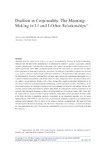Mostrar o rexistro simple do ítem
Dualism in corporeality: the meaning-making in I-I and I-Other relationships
| dc.contributor.author | Silva Guimarâes, Danilo | es_ES |
| dc.contributor.author | Mathias Simâo, Livia | es_ES |
| dc.date.accessioned | 2014-10-02T12:31:41Z | |
| dc.date.available | 2014-10-02T12:31:41Z | |
| dc.date.issued | 2012 | es_ES |
| dc.identifier.citation | Culture of communication / Communication of culture, 2012: 1185-1194. ISBN: 978-84-9749-522-6 | es_ES |
| dc.identifier.isbn | 978-84-9749-522-6 | es_ES |
| dc.identifier.uri | http://hdl.handle.net/2183/13382 | |
| dc.description.abstract | [Abstract] Departing from the notion of the body as an agency, as proposed by Viveiros de Castro’s Amerindian perspectivism, the aim of this presentation is to articulate the notion of agentive corporeality with the notions of belongingness and otherness as discussed in the frame of the semiotic-cultural constructivism in psychology (Simão, 2005; 2008). Among the possibilities for this articulation, we will take here the aspect of the expression of meanings in corporeal inscriptions. According to Amerindian perspectivism, the body as an agentive substance dwells images which are inscribed in it. This process of body inscription allows the objectification of cultural meanings about the roles, rights and duties, expectations and possibilities of a subject in his/her relationships with his/her others. In sum, inscriptions can be viewed as indicatives of the subject’s action potential (Boesch, 1991). They emerge from cognitive-emotional elaborations of the individual’s collective experiences and are constraining, in their expression, by them. For instance, in the Amerindian context, the newborn is formerly taken as a stranger, as someone who nobody knows, until his body receives some inscriptions by specific older others. It is through this cultural construction in the newborn body that she/he becomes a «relative of his/her relatives» (Viveiros de Castro, 2002). From then on, some of his/her actions will receive group validation, while others will be prevented. In other words, at the birth, the body is something «generic», considered as not completely provided with the group signals (Taylor, 1984/1996). In such an extent, the personal development is marked by the transformative symbolic action (Boesch, 1991) of others on the subject’s formerly unmarked body. The kind of I-Other relationship here illustrated, according to the theoretical frames here put in dialogue, can lead us to deepen our discussion about the path of becoming as coordinated by structural and processual levels in human development. | es_ES |
| dc.language.iso | eng | es_ES |
| dc.publisher | Universidade da Coruña | es_ES |
| dc.title | Dualism in corporeality: the meaning-making in I-I and I-Other relationships | es_ES |
| dc.type | info:eu-repo/semantics/conferenceObject | es_ES |
| dc.rights.access | info:eu-repo/semantics/openAccess | es_ES |






